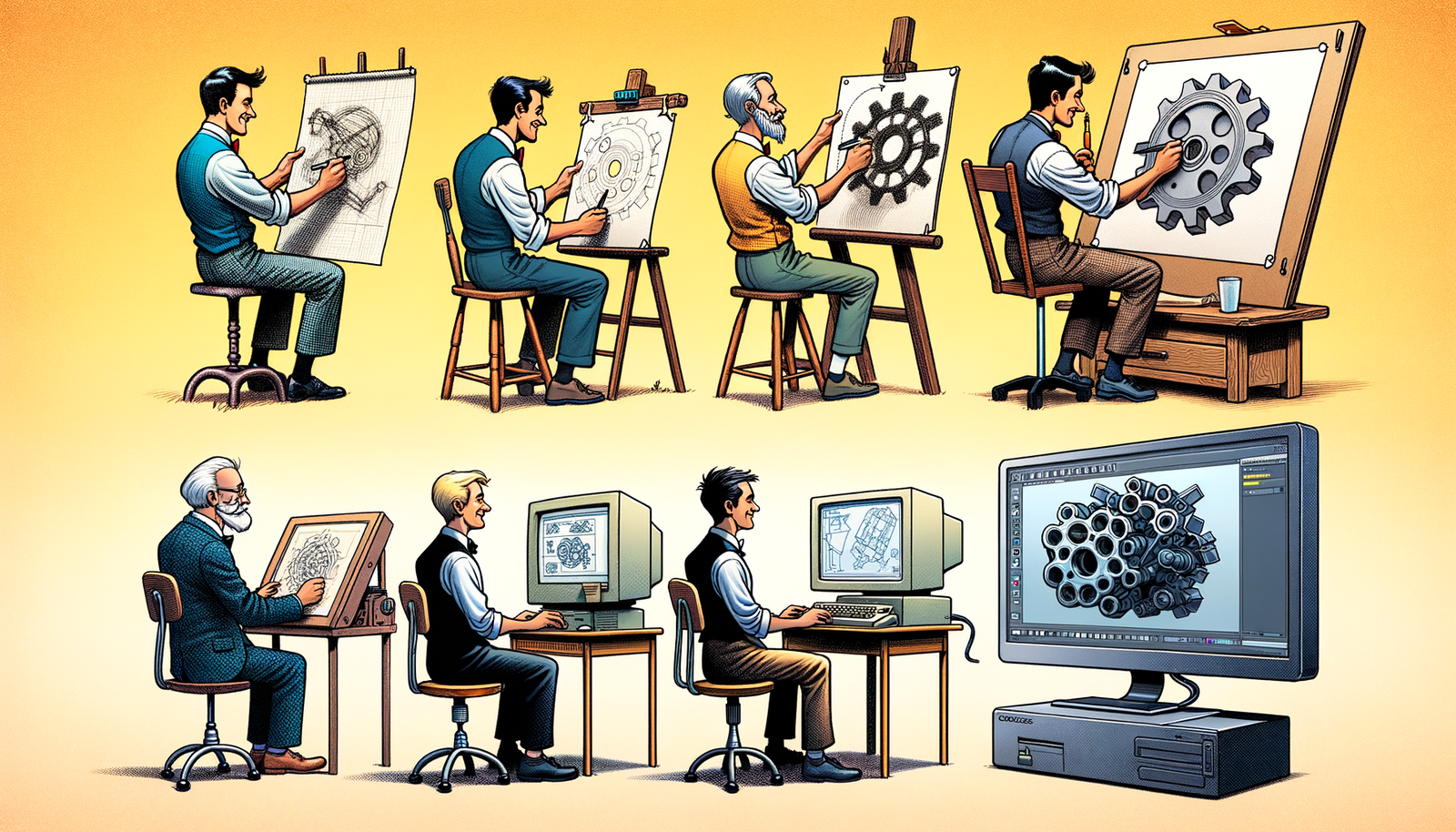Your Cart is Empty
Customer Testimonials
-
"Great customer service. The folks at Novedge were super helpful in navigating a somewhat complicated order including software upgrades and serial numbers in various stages of inactivity. They were friendly and helpful throughout the process.."
Ruben Ruckmark
"Quick & very helpful. We have been using Novedge for years and are very happy with their quick service when we need to make a purchase and excellent support resolving any issues."
Will Woodson
"Scott is the best. He reminds me about subscriptions dates, guides me in the correct direction for updates. He always responds promptly to me. He is literally the reason I continue to work with Novedge and will do so in the future."
Edward Mchugh
"Calvin Lok is “the man”. After my purchase of Sketchup 2021, he called me and provided step-by-step instructions to ease me through difficulties I was having with the setup of my new software."
Mike Borzage
Design Software History: The Evolution of Industrial Design Software: From Hand-Drawn Sketches to Parametric and Solid Modeling
September 27, 2024 5 min read


The Early Beginnings of Industrial Design Software
Traditional Industrial Design Methods
Before the advent of modern technology, industrial design was a craft that relied heavily on manual techniques and the skilled hands of designers and craftsmen. The process was rooted in hand-drawn sketches and physical models, which were essential tools for visualizing and refining product concepts. Designers would spend countless hours drafting intricate designs on paper, using tools like pencils, compasses, and drafting tables to create detailed plans. These sketches served as the primary means of communicating ideas, both within design teams and with clients or manufacturers. The tactile nature of drawing allowed for a personal connection to the design, but it also introduced significant limitations.
One of the major challenges of this traditional approach was the lack of precision compared to today's standards. While highly skilled designers could produce accurate representations, the process was inherently prone to human error. Dimensions had to be calculated and drawn manually, which made it difficult to achieve the exactness required for complex industrial products. Moreover, the creation of physical models, often made from clay, wood, or foam, was time-consuming and labor-intensive. These models were crucial for assessing the form and ergonomics of a product, but any changes required starting over or making painstaking adjustments to the existing model.
The iterative nature of design meant that multiple cycles of sketching and prototyping were necessary to refine a product. Each iteration could take days or weeks, significantly slowing down the development process. The limitations in precision and time-consuming iterations hindered the ability to respond quickly to market demands or incorporate feedback efficiently. Collaboration was also more challenging, as sharing physical sketches and models required physical presence or the cumbersome process of mailing documents and models between parties. These constraints highlighted the need for more efficient methods that could enhance accuracy, speed up iterations, and facilitate better collaboration among designers, engineers, and manufacturers.
Emergence of Computer-Aided Design (CAD)
The landscape of industrial design began to shift with the introduction of basic CAD systems in the 1960s and 1970s. This period marked the early stages of integrating computer technology into the design process, offering the potential to overcome many limitations of traditional methods. Computers were initially used for numerical calculations, but innovators soon recognized their potential for handling graphical data and assisting in design tasks. Early CAD systems were developed primarily for specialized applications in industries like aerospace and automotive, where the complexity of products demanded more precise and efficient design tools.
A pivotal moment in the history of CAD was the creation of Sketchpad in 1963 by Ivan Sutherland, often referred to as the father of computer graphics. Sketchpad was revolutionary because it allowed users to interact directly with a computer graphics display using a light pen, enabling them to draw geometric figures and manipulate them on the screen. This groundbreaking system introduced key concepts such as hierarchical drawings and constraints, which are fundamental to modern CAD software. Sutherland's work demonstrated the immense potential of computers to enhance the design process by increasing precision and allowing for easier modifications.
The development of CAD technology during this era was driven by the need to improve design accuracy and reduce the time required for iterations. Early CAD systems were capable of creating two-dimensional drawings with greater speed and accuracy than manual drafting. They also provided the ability to store and retrieve designs electronically, which facilitated better organization and sharing of information. However, these systems were limited by the computing power and graphical capabilities of the time. Despite these limitations, the emergence of CAD signified a critical shift toward digitizing the design process, laying the foundation for the sophisticated software tools used today.
Pioneering Companies and Innovators
The advancement of CAD technology was propelled by the efforts of pioneering companies and visionary individuals who recognized the transformative potential of computers in design. Among these innovators was Dr. Patrick Hanratty, often called the "Father of CAD." In 1957, Hanratty developed PRONTO (Program for Numerical Tooling Operations), one of the first numerical control programming systems for machine tools. His work laid the groundwork for the integration of design and manufacturing, leading to more efficient production processes.
In the commercial realm, companies like CADAM (Computer Augmented Design and Manufacturing) and Computervision were instrumental in bringing CAD technology to various industries. CADAM was developed in the early 1970s by engineers at Lockheed to improve the design of aerospace components. Its success demonstrated the practical benefits of CAD in managing complex engineering projects. Computervision, founded in 1969, was one of the first companies to focus solely on developing CAD systems. They introduced interactive graphics terminals and software that enabled more designers to adopt CAD in their work.
These early companies faced significant challenges, including the high cost of computer hardware and the need to develop software from the ground up. However, their contributions were crucial in demonstrating the viability of CAD as a tool for improving design efficiency and accuracy. Their innovations paved the way for the widespread adoption of CAD technology, influencing subsequent developments and inspiring further investment in research and development. The collaboration between industry leaders and computing pioneers during this period set the stage for the rapid advancements that would follow in the subsequent decades.
Evolution Through the Digital Revolution
Transition from 2D to 3D Modeling
The 1980s and 1990s witnessed a significant evolution in industrial design software with the shift from two-dimensional drafting to three-dimensional modeling. This transition was fueled by advancements in computing power and graphics technology, which made it feasible to render complex 3D models on desktop computers. The ability to create three-dimensional representations of products brought a new level of realism and functionality to the design process, allowing designers to visualize their creations in a more holistic and interactive manner.
Three-dimensional modeling provided several advantages over traditional 2D drafting. It enabled enhanced visualization of designs, allowing designers and stakeholders to see how a product would look and function in the real world. This was particularly beneficial for identifying potential issues related to fit, form, and function before committing resources to physical prototypes. Additionally, 3D models could be easily rotated, zoomed, and manipulated, providing a more intuitive understanding of the product's geometry.
The shift to 3D modeling also facilitated better communication and collaboration among multidisciplinary teams. Engineers, designers, and manufacturers could work from a shared digital model, reducing misunderstandings and discrepancies that often arose from interpreting 2D drawings. Furthermore, 3D models served as the basis for simulations and analyses, such as stress testing and motion studies, which were crucial for optimizing product performance. This transition marked a significant step toward a more integrated and efficient design process, aligning with the broader digital revolution that was transforming industries worldwide.
Introduction of Parametric and Solid Modeling
A major milestone in the evolution of industrial design software was the advent of parametric modeling, introduced by PTC with the release of Pro/ENGINEER in 1988. Parametric modeling revolutionized the way designs were created and modified by allowing parameters and relationships to drive the geometry of the model. Designers could define key dimensions and constraints, and any changes to these parameters would automatically update the entire model accordingly. This approach significantly reduced the time required for design iterations and ensured consistency throughout the design.
The concept of solid modeling also emerged during this time, providing a more comprehensive representation of objects compared to wireframe and surface models. Solid models
Also in Design News

2D/3D Animation:Collaboratory with Mike Morris and Aaron Paetz
February 20, 2025 1 min read
Read More
ZBrush Tip: Enhancing Organic Sculpting Techniques in ZBrush: Key Tips and Resources
February 20, 2025 2 min read
Read More
Revit Tip: Mastering Revit's Edit Profile Tool for Customized Design Efficiency
February 20, 2025 2 min read
Read MoreSubscribe
Sign up to get the latest on sales, new releases and more …


